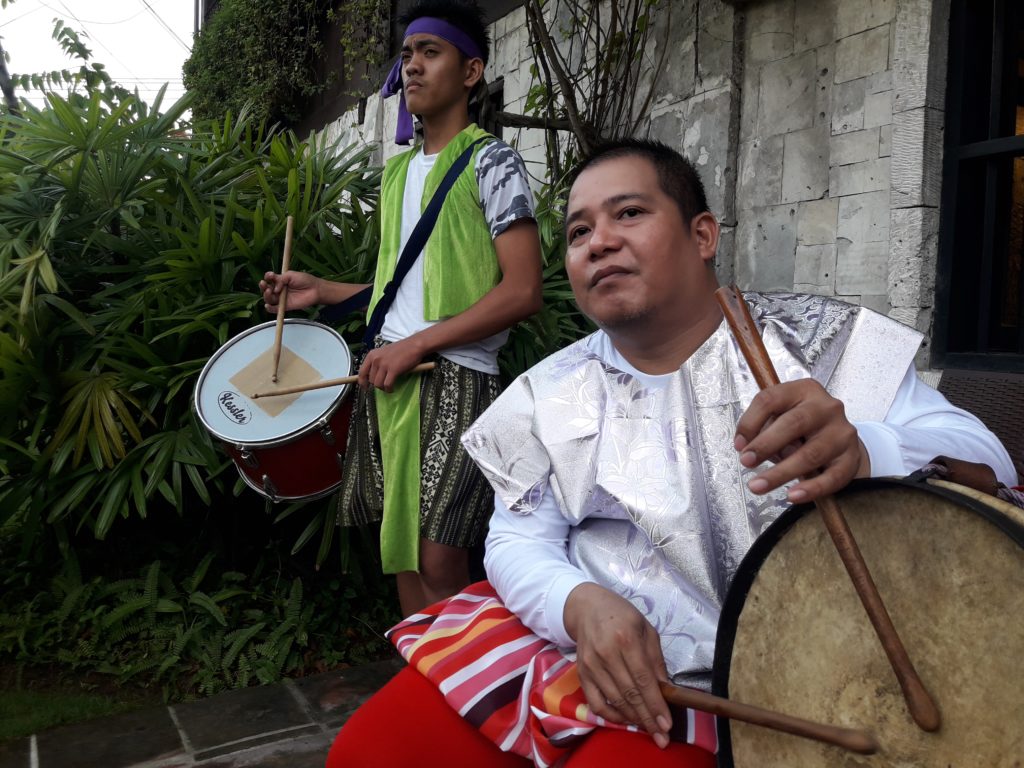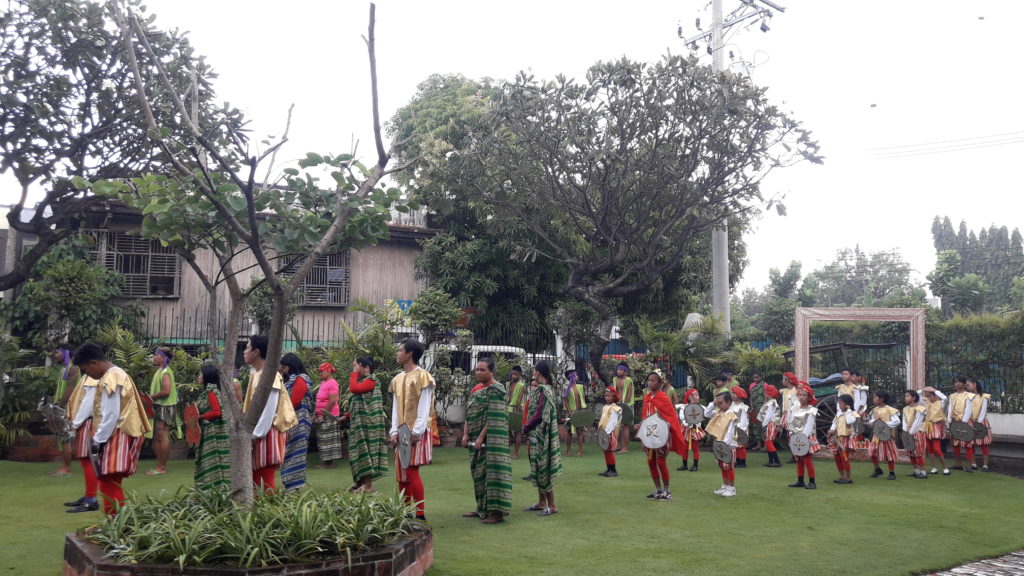‘Do not forget the traditional sinug’

Richeleu “Richoy” Colina plays the drum during the Sinug sa Casa Gorordo. / Cris Evert Lato-Ruffolo
CEBU CITY, Philippines – In the beginning, there was the simple dance of prayer.
It existed way before the elaborate costumes and the crowded streets brought about by the Sinulog festival.
It was the dance that Richeleu “Richoy” Colina learned from Estelita “Nang Titang” Diola when he was only 10 years old.
The dance that mimics the sulog/sug or flow of the river and performed in honor of the Señor Sto. Niño.
Richoy spent many afternoons in the house of Nang Titang in Barangay Mabolo, where his grandmother, Antoinetta Colina, used to hang out.
Richoy said his relationship with Nang Titang started out because of a business transaction that involved ducks.
Nang Titang, who never married and never had children of her own, raised ducks in her yard and the young Richoy found the opportunity to buy her ducks at P35 each and then sell it to a Chinese businessman at P70 each.
They were business associates, so to speak.
As Richoy spent more afternoons with Nang Titang, the woman took him under her wing, treating him like her own.
Nang Titang’s fondness for him led her to teach Richoy a gift that he still owns up to this day.
“Nang Titang was the daughter of Buenaventura or Turang, who was known for leading the sinug sa Mabolo. Nang Titang knew the dance, the beat, the prayers. She learned how to play the drum from Mariano Bontilao. She taught me everything I know. I was a child willing to learn,” Richoy told Cebu Daily News Digital.
Now 44 years old, Richoy leads Turang Dance Troupe, the same group that Nang Titang led for decades until she passed away on March 2013.
The group performs in the annual Sinug sa Casa Gorordo, which falls on the Monday after the Sinulog Grand Parade.
This year, it was held on January 21.
Sinug sa Casa Gorordo is a house tradition of the Gorordo family and was continued by the Ramon Aboitiz Foundation Inc. (RAFI) when they transformed the house into a museum.
Altar
The statue of the Sto. Niño is never carried in the entire dance.
Instead, an altar is positioned infront, which, according to Richoy, serves as the central focus of the entire dance.
Choreographer Cesar Nimor, in a talk in Casa Gorordo last year, said that the natives already danced the sinug even before Portuguese navigator Ferdinand Magellan arrived in Cebu on April 7, 1521.
Nimor said the sinug was performed by natives as supplication to deities and nature spirits called diwata.
“We can’t really explain where—and how it started because it is a tradition. It is not Spanish-influenced. It is very, very indigenous,” he said.
Watching the dance is like a crash course on Cebuano heritage, culture and religion, said Wang Mingyun, a tourist from Shenzhen, China.
Before coming to Cebu, she only heard of the white-sand beaches and clear waters.
“But since we experienced Sinulog, I learned more about your interesting culture,” said Wang, who dropped by Casa Gorordo to check the museum.
What she saw was more than what she expected.
Richoy said the dance starts with alabacion or when the lead performer says a prayer infront of the altar.
After alabacion, halad (offering) is done. This is when the leader utters the names of the sick and those who passed away. The names of those who pray for good health, children and other blessings are also mentioned.
Sayaw natural is then performed followed by the singing of a Spanish song, Señor del Universo.
“The song is a Christmas carol which talks about a family and how a woman, Mama Mary, gave birth to the Child Jesus,” shares Richoy after the Sinug sa Casa Gorordo on January 21.
The dance also includes the singing of Sagalas Compañeros, a thanksgiving song; the tumbling or balitok, which is meant to entertain and play with the Holy Child; the singing of a song that centers on celebration; and the traditional combat between Christians and Moros.
The dance ends with a Visayan song of farewell or panamilit.

Residents of Barangay Mabolo perform the traditional Sinug dance which Richoy learned from Nang Titang Diola and which he also taught to his dancers. / Cris Evert Lato-Ruffolo
Costumes
The dance that Richoy grew up to is referred to as the “combative sinug,” which follows the 4/4 time signature of the beating drums.
The exemption is for the pakli step or the kinampilan, which is in the 3/4 time signature.
“The kinampilan step is for good harvest. It is a prayer step so that no pests will harm our plants,” he said.
Richoy said there is also a step called wakli, which literally means “push way,” in reference to pushing bad luck and misfortunes.
In this version of the sinug dance, the performers wear costumes resembling Christians and Moros.
Richoy said traditionally, males are the Christians, the females are the Moros.
But the number of boys and girls usually sways in favor of the latter so there were years when the roles were interchanged.
Performers carry harmless swords and shields as props as part of the dance.
Relevance
Richoy said the dance troupe has more than 100 volunteer performers from Barangay Mabolo.
The dancers are between the ages of seven and 60-years-old.
The costumes are sewn by Richoy himself. The performers also contribute money for their costumes. Val Sandiego of the Sandiego Dance Company donates cloth.
Children spend days and weeks learning the Spanish songs.
“It can be a tricky exercise because these children do not speak Spanish. But I always make it a point to translate the song to them so they will understand the meaning,” he said.
Richoy said it is important to teach children the tradition that has been passed on from one generation to the next so they stay loyal to their roots and not be easily swayed by pop culture.
This tradition is reflected in the traditional sinug dance.
“The entire routine has canta pasalamat or song of thanks. There is tumbling or balitok which is meant to entertain the Sto. Niño… a form of play. There is another song for celebration. I teach them these because I do not want them to have identity crisis. This is part of them,” he said.
Richoy said movements such as tukod espada (saber arch) and estocada (fencing) have to be explained to the children so they will understand the relevance of what they are doing.
“Tukod-espada is an honorary march that expresses, ‘Ikaw among hari. We honor you.’ We need to teach this to the younger generation so they will not forget,” shared Richoy. /dcb
Disclaimer: The comments uploaded on this site do not necessarily represent or reflect the views of management and owner of Cebudailynews. We reserve the right to exclude comments that we deem to be inconsistent with our editorial standards.
